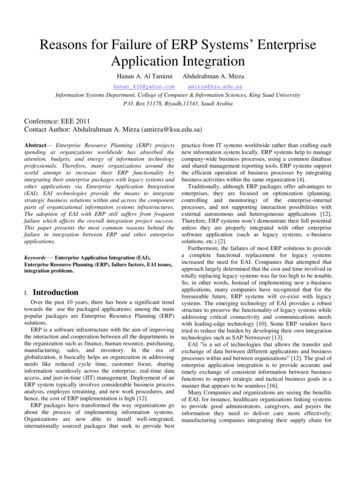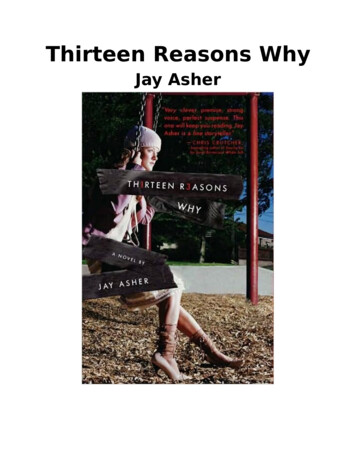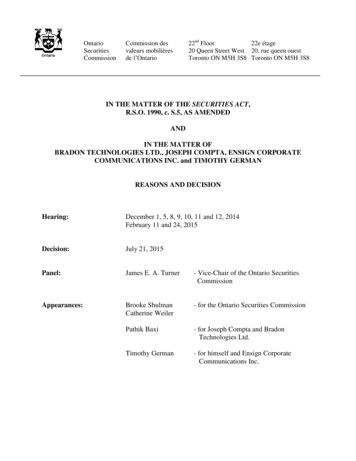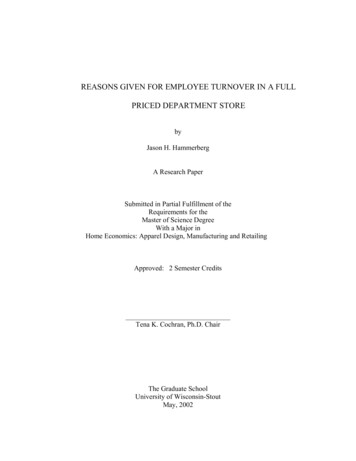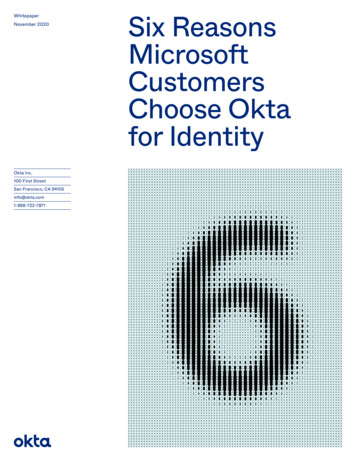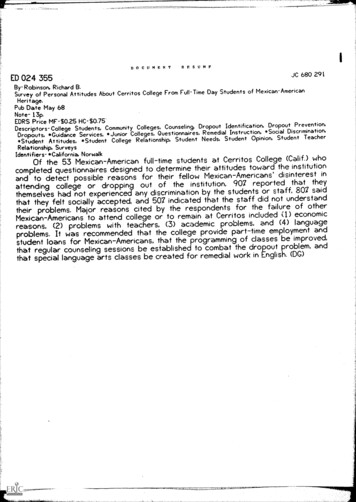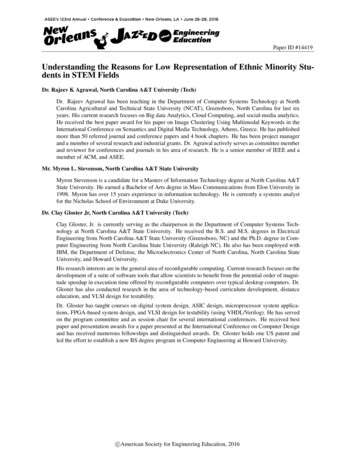
Transcription
Paper ID #14419Understanding the Reasons for Low Representation of Ethnic Minority Students in STEM FieldsDr. Rajeev K Agrawal, North Carolina A&T University (Tech)Dr. Rajeev Agrawal has been teaching in the Department of Computer Systems Technology at NorthCarolina Agricultural and Technical State University (NCAT), Greensboro, North Carolina for last sixyears. His current research focuses on Big data Analytics, Cloud Computing, and social-media analytics.He received the best paper award for his paper on Image Clustering Using Multimodal Keywords in theInternational Conference on Semantics and Digital Media Technology, Athens, Greece. He has publishedmore than 50 referred journal and conference papers and 4 book chapters. He has been project managerand a member of several research and industrial grants. Dr. Agrawal actively serves as committee memberand reviewer for conferences and journals in his area of research. He is a senior member of IEEE and amember of ACM, and ASEE.Mr. Myron L. Stevenson, North Carolina A&T State UniversityMyron Stevenson is a candidate for a Masters of Information Technology degree at North Carolina A&TState University. He earned a Bachelor of Arts degree in Mass Communications from Elon University in1998. Myron has over 15 years experience in information technology. He is currently a systems analystfor the Nicholas School of Environment at Duke University.Dr. Clay Gloster Jr, North Carolina A&T University (Tech)Clay Gloster, Jr. is currently serving as the chairperson in the Department of Computer Systems Technology at North Carolina A&T State University. He received the B.S. and M.S. degrees in ElectricalEngineering from North Carolina A&T State University (Greensboro, NC) and the Ph.D. degree in Computer Engineering from North Carolina State University (Raleigh NC). He also has been employed withIBM, the Department of Defense, the Microelectronics Center of North Carolina, North Carolina StateUniversity, and Howard University.His research interests are in the general area of reconfigurable computing. Current research focuses on thedevelopment of a suite of software tools that allow scientists to benefit from the potential order of magnitude speedup in execution time offered by reconfigurable computers over typical desktop computers. Dr.Gloster has also conducted research in the area of technology-based curriculum development, distanceeducation, and VLSI design for testability.Dr. Gloster has taught courses on digital system design, ASIC design, microprocessor system applications, FPGA-based system design, and VLSI design for testability (using VHDL/Verilog). He has servedon the program committee and as session chair for several international conferences. He received bestpaper and presentation awards for a paper presented at the International Conference on Computer Designand has received numerous fellowships and distinguished awards. Dr. Gloster holds one US patent andled the effort to establish a new BS degree program in Computer Engineering at Howard University.c American Society for Engineering Education, 2016
Understanding the Reasons of Low Representation of EthnicMinority Students in STEM FieldsAbstract— North Carolina is becoming a state known for STEM. Its expected job growth inSTEM related industries ranks in the top third nationally with Charlotte and Raleigh consistentlyranking in the top 100 metropolitan areas for STEM careers. The state’s universities produced21,191 STEM graduates in 2014, the 10th most in the United States according to the Departmentof Education. Between the 2012-2013 and 2013-2014 academic years, North Carolinauniversities produced the 10th most underrepresented minority graduates in STEM fields in thenation. My College Options and STEMconnector report 26.2% of North Carolina High Schoolstudents are interested in STEM compared to 25.5% nationally for 2013. Statistically, NorthCarolina is a model for increasing diversity in STEM fields, but a large inclusion gap remains inSTEM graduates. From 2009 through 2013, North Carolina universities produced four timesmore White engineering and computer science undergraduates than African American, NativeAmericans, and Hispanic engineering and computer science undergraduates combined.Considering the universities’ overall production of STEM graduates, and the amount of highschool students interested in STEM, an analysis of the effectiveness of North Carolina’s K-12public schools instruction on underrepresented minorities is required. Underrepresentedminorities historically score lower than White and Asian American students on standardizedmath exams, a common metrics used to determine math aptitude. By utilizing literature reviewsof previous research on the topic and analyzing the teacher population of North Carolina’s K-12public schools, standardized math exam scores of North Carolina’s 3rd, 4th and 8th grade students,and the effects of economic conditions have on students’ education, we hope to better understandand highlight the circumstances that are preventing an increase in STEM diversity in NorthCarolina. We propose increasing the number of ethnic minority educators, improve culturaltraining for educators by implementing cultural relational teaching methods into standardcurriculum including more hands-on instruction, a redistribution of financial resources to statepublic educational institutions, including higher education, based on need instead of population.We believe these changes have the potential to increased interest and self-efficacy in math andscience for underrepresented minority students of North Carolina.I. IntroductionThe US Department of Commerce reports employment in Science, Technology, Engineering,and Mathematics (STEM) careers is expected to grow 17% by 2018 compared to 10% for nonSTEM careers. In North Carolina, 229,000 new STEM jobs are expected, which ranks 15 thnationally according to US Bureau of Labor Statistics, 2011. Workers in STEM have higherwages and lower unemployment according to the US Bureau of Labor Statistics, with workers incomputer, mathematical, architecture, and engineering occupations in North Carolina earning anannual mean salary between 73,390 and 80,550.Despite recruiting and education efforts, underrepresented minorities, (African Americans,Native Americans, and Hispanics) continue to be underrepresented in STEM. In 2011 nonHispanic Whites represented roughly 67% of the total workforce, but held 71% of STEM jobs.Asians held 15% of the STEM jobs compared with 6% of all jobs. African Americans held 6% ofSTEM-related jobs, Native American held 0.4% of STEM jobs, and those of “Some Other Race”
held 1% of STEM jobs, while representing 27% of all jobs”[1]. According to 2013 data from theComputer Research Association, 4.5% of all new computer science or computer engineeringdegree holders were African American, and 6.5% were Hispanic. Between 2009 and 2013, thenumber of ethnic minority engineering graduates increased by 12.3%, compared to increases of22.75% and 19.72% for White and Asian graduates.North Carolina has a number of nationally and internationally recognized universitiesproducing STEM graduates, including the top producer of Native American biological,biomedical, and physical science graduates, and the top producer of African Americanengineering and natural resources conservation graduates according to Diverse Issues In HigherEducation magazine. However, there remains a large gap between the overrepresented and theunderrepresented entering and graduating with STEM related majors. Improving NorthCarolina’s K-12 educational system by implementing proven methods of relational teaching andimmersion programs have the potential to improve the academic success and interest ofunderrepresented minorities while simultaneously increasing diversity in STEM industries withinthe state.The lack of underrepresented minorities (URMs) within the sciences has been studiedthoroughly since the White House and Department of Education have given added emphasis toSTEM. Though there have been numerous studies on why STEM fields lack diversity, nostudies have been conducted on North Carolina, a state which is a top producer of minoritySTEM graduates, but has a large gap between the underrepresented and overrepresented. This isevident by the combined 13% increase in URMs graduating with bachelors degrees inengineering or computer science compared to the 23% increase in White undergraduates and the20% increase in Asian American undergraduates.II. North Carolina Higher EducationNorth Carolina is home to four of the top 100 ranked US News and Reports nationaluniversities and six of the top ranked Historically Black Colleges and Universities (HBCU) [2].Of these universities, North Carolina Agricultural and Technical State University (NCA&T) andNorth Carolina State University (NCSU), rank in the top 10 for producing URM minorityengineers.NCA&T graduates the largest number of African American engineering undergraduate,master and doctoral students in the US. NCA&T is the nation’s largest producer of minorityagricultural graduates. NCA&T’s online Masters of Information Technology ranked 16 th for BestOnline Graduate Computer Information Technology Programs in the US by US News andReports. NCSU made “Diverse Issues in Higher Education” Magazine’s Top 100 DegreeProducers list in physical science, biological and biomedical sciences based on number ofdegrees awarded to African American, Hispanic, Asian American and Native American studentsin 2008-09. NCSU also ranked: No. 6: doctorates in math and statistics awarded to all minorities;No. 10: doctorates in engineering for African Americans; No. 11: doctorates in engineering forHispanic; No. 12: master’s degrees in engineering for African Americans; No. 16: undergraduatedegrees in engineering for African Americans [3].
University of North Carolina Pembroke (UNCP) originally began as a teacher college forNative Americans in 1887. In 1970, the university extended its STEM offerings to address theneed for more Native American doctors, engineers, and scientists within the predominatelyNative American community of Pembroke, N.C. Over that time period, UNCP has producedmore than fifty Native American doctors. Diverse Issues in Higher Education Magazine ratedUNCP as the nation’s top producer of Native American Biological, Biomedical, and PhysicalScience undergraduates.III. Factors Affecting UnderachivementAcademic success or failure is affected by multiple factors. This research will highlightfactors in North Carolina including teacher bias, financial concerns, lack of preparation in K-12education, and family and communal influence.A. Historical Racial Biases and Low Academic ExpectationsExpectations and attitudes of educators play an important role in the academic success ofstudents. As of 2015, ethnic minorities represented 18% of North Carolina public schoolsteachers and 28% of school administrators. The low representation leaves URMs with fewpeople in leadership roles that look like them resulting in minority students’ reality being notacknowledged and low expectation of academic performance based on race by teachers [4].Some White educators sub conscientiously have low academic expectations of ethnicminority students, based on stereotypes that view them as academically or intellectually inferiorto White and Asian students. The low academic expectations perpetuate notions of school beingonly for Whites and Asians among URM high school students. The sustaining of this notionleads to lower confidence in academic ability and to these students deliberately sabotaging theiracademic performance [5]. When URMs achieve high academic success, teachers with lowexpectations attribute the success to extenuating factors rather than intellectual ability. Thisdevaluation of achievement creates tension and distrust between the student and instructor whichultimately leads to the student behaving in tune with the teacher’s expectation [4]. Highachieving URM students can suffer from stereotype threat, a social-psychological predicamentthat can arise from widely known negative stereotypes about one's group [6], due to teacher lowexpectations for URM students. Empirical evidence has shown the pressure of not confirming orconforming to negative stereotypes can result in the student not performing to their highestpotential [6].Standardized testing is a common metric used to predict academic success. Previous researchhas proven that standardized testing is biased towards White students as these tests arestandardized in predominately White schools, emphasizing White, middle-class culture whileignoring other cultures, role models, and alluding to negative perceptions of non-White people[4]. For example, according to the College Board, the 2011-2012 Computer Science AP examwriters were overwhelmingly White male, with women representing 19%, African-American4.5%, Hispanic 8.4%, and Native American/Alaska Native 0.3% of exam writers.
B. Financial ConcernsWhen economic status is equal, previous research has shown no statistical difference inacademic performance between the URM and White students. This can be attributed to equalaccess to resources. North Carolina had the 34th highest percentage of people living in poverty inthe US for 2014 with the percentage of Whites nearly 2 times lower than URMs, according to theUS Census Bureau. For 2013, The National Center for Children in Poverty statistics shows NorthCarolina had the highest percentage of Hispanics and the 20th highest percentage of AfricanAmerican children, 18 and under, living below the federal poverty line in the nation. Both ofthese statistics are higher than the national average.Eighty of North Carolina’s 100 counties are considered rural, which are more likely thanurban counties to have high levels of poverty, as they are less populated with fewer industries.State funding for K-12 is based on formulas that utilize the number of students and other targetedfactors resulting in more populous counties receiving more funding. It is important to note NorthCarolina Department of Public Instruction (NCDPI) reports the state’s most financiallydistressed schools are predominantly comprised of low income URMs. The National EducationAssociation ranks the state in the bottom five for per-pupil expenditures due to budget cuts.Federal and state budget cuts to higher education have made attaining a college educationmore difficult for all people, but more so for URMs. Hurtado and others found that ethnicminorities are more likely to have concerns over paying for their education. Their researchindicated that underrepresented minorities work more hours in high school and are more likely towork full time during college, making it more difficult to focus on academics [7]. Federaleducation funding has been cut over 300 million including cuts to Title III, the Parent Plus LoanProgram, Pell grants, and graduate subsidies in 2011 [8], which benefit low-income and workingclass students.Adding to the burden of paying for college, the College Board reports the average collegetuition has increased by 50% since 2000. February 2015, the UNC Board of Governors, agreedto an average 4.3% tuition increase for in-state undergraduates across all state universitiesfollowed by a 3.7% increase in 2016. This is after a 9.9% tuition increase in 2012-2013. Withcuts to financing programs and other federal grants, the burden of paying for college may detereconomically disadvantaged URMs from going to college or graduating from college.The effects of the budget cuts and tuition increases can be seen in the decrease in enrollmentat HBCUs. Of the eleven HBCUs in NC, only three saw enrollment percentage increases in fulltime students, while seven saw double digit decreases from 2010-2013. Smaller colleges anduniversities such as HBCUs and UNCP, which are URM dominated, have smaller endowmentsand depend heavily on tuition dollars and government funding to continue operations.C. Lack of Preparation in K-12Participating in advanced math courses prepares students for more rigorous collegiate mathcourses, which typically are requirements for STEM related majors. The National ActionCouncil for Minorities in engineering reports twice as many White American high school
students take calculus courses than URM students. Asian American high school students takecalculus at a rate seven times higher than URM students [9]. With URMs historically scoringlower than White and Asian American students on standardize math exams, it is fair to sayURMs are not prepared to take higher-level math courses such as calculus.In 2015 more URM students enrolled in Advance Placement (AP) courses than previousyears according to NCDPI, but it’s important to note AP courses in North Carolina publicschools have open enrollment, meaning any student, regardless of academic qualification mayenroll in AP courses. School administrators advise students based on their academic record, butthe final decision is left to the student and their parents. Some school systems do haverequirements such has earning a “C” in pre-calculus before being allowed to enroll into APcalculus, but this is not the standard operation for all North Carolina public schools. As a resultof open enrollment only 32.7% of URMs had scores of “qualified” or higher compared to 65% ofAsian and 58% of Whites for the 2014-2015 academic year.Not all of North Carolina’s rural and impoverished school systems offer AP courses due tothe lack of teachers qualified to teach AP courses in the district. The lack of this importantresource results in rural students being ill prepared for college level math and science courses ata greater rate than metropolitan students. This lack of academic resources is reflective of thesocioeconomic disparity between regions.This is not surprising since URM primary and middle grade math scores are much lower thantheir White and Asian peers. North Carolina students’ average National Assessment ofEducational Progress (NAEP) math score for fourth graders was four points higher than thenational average of 240 in 2015. URMs average score was 232, eight points lower than thenational average and 21 points lower than White students. Eighth graders’ scores for all NorthCarolina students was equal to the national average of 281 while URMs of North Carolinaaverage score was 268, 13 points lower than national and state averages and 24 points lower thanNorth Carolina’s White students. This is indicative of the lack of early preparation of NorthCarolina’s URMs in math, leading to less participating in upper level math courses in highschool.D. Family and Community EffectsFamily and community have a great deal of influence on decisions, self-confidence, andperspectives on academics. A misconception of URM students is they fear of being labeled a“sellout” or “acting white”. This is based on Dr. John Ogbu oppositional culture theory, whichstates that by conforming to school requirements (attaining good grades, speaking and writing“proper” English, and good behavior) is considered as “acting white” and giving up one’sminority identity [10]. More recent research has proven this theory does not apply for allminorities as quantitative data shows that the oppositional culture theory’s explanation for theacademic gap is limited [11]. For example, a 2006 CBS News Poll on students opinions onschool showed African-American students had higher perceived academic success as “cool” andtook pride in high academic achievement at higher percentages than their White peers [12].
Parents have the greatest influence on academic performance. Encouragement andintegration of academics into daily activities helps minorities not commit “academic suicide”according to Dr. James Moore [13]. Research has shown students with highly educated parentstypically perform higher academically. In 2010, the US Census reported 10% of the populatione
Myron Stevenson is a candidate for a Masters of Information Technology degree at North Carolina A&T . immersion programs have the potential to improve the academic success and interest of . (UNCP) originally began as a teacher college for Native Americans in 1887. In 1970,

